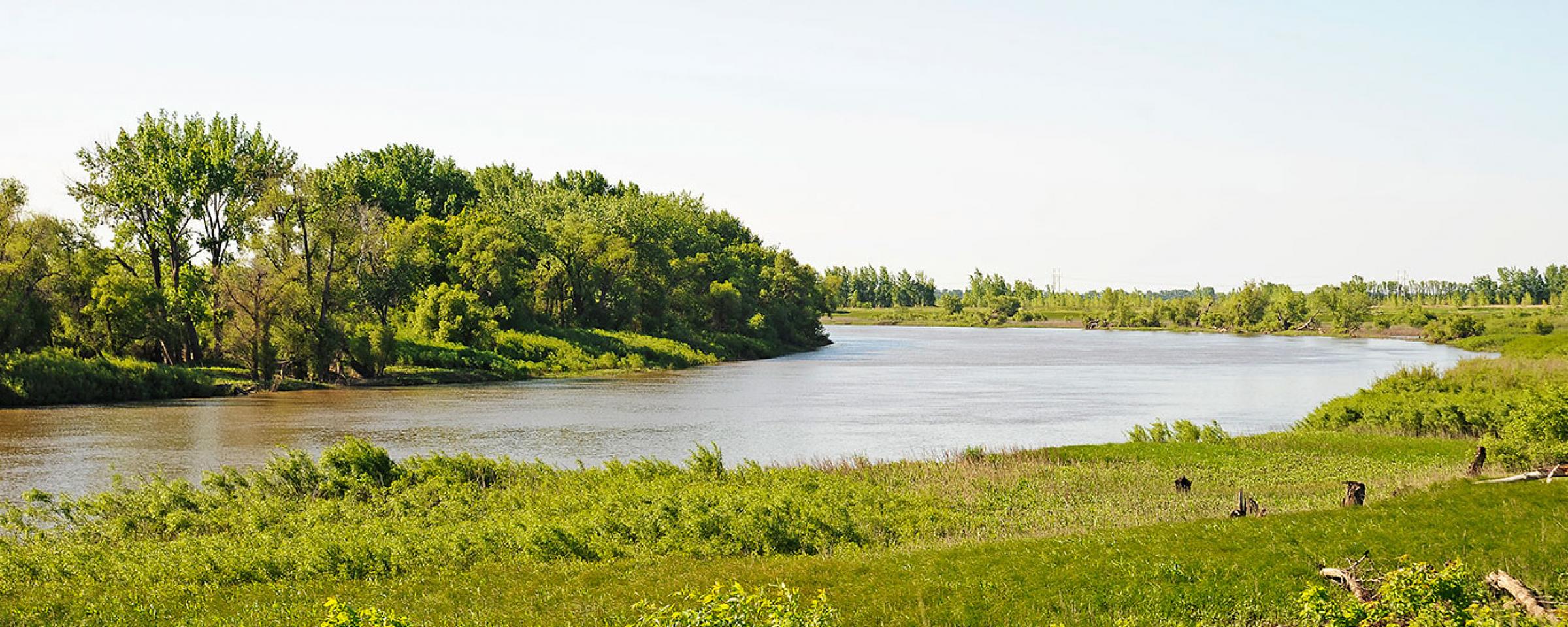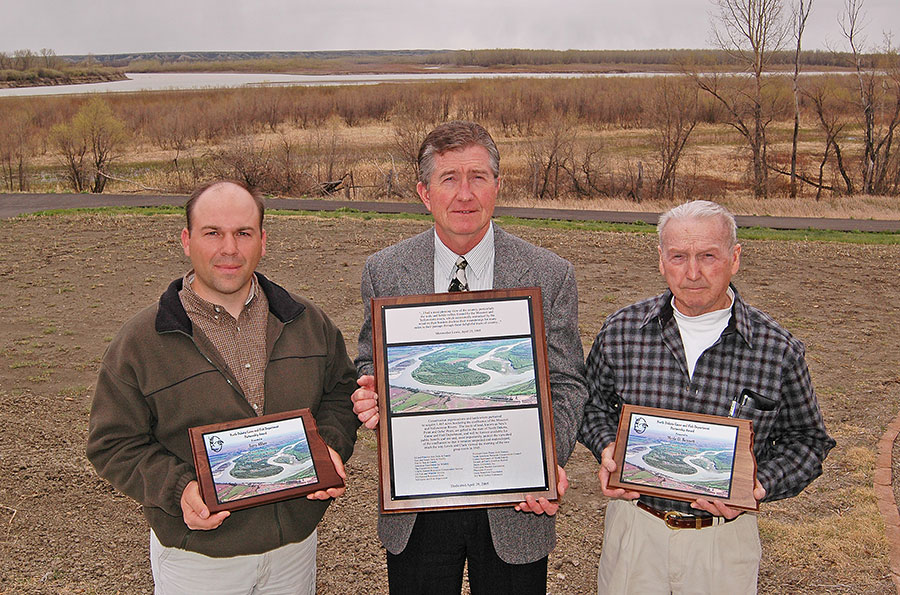
Natural Resources Trust Celebrates 30 Years
What began as a “Hail Mary” by then-Governor George Sinner and a handful of water leaders to help curb animosity between wildlife and agriculture interests in the 1980s, is now celebrating 30 years of on-the-ground programs designed to benefit both agriculture producers and wildlife conservation efforts.
The North Dakota Natural Resources Trust, as it is now called, was born from controversy over the Garrison Diversion Unit, a massive federal government project that promised 250,000 acres of irrigation in North Dakota as the state’s repayment for giving up 400,000 acres of Missouri River bottomland, pasture and cropland for the creation of the Garrison Dam and its reservoir, Lake Sakakawea.
Construction of Lake Audubon and the Garrison Diversion Canal, which was originally intended to carry Missouri River water to the headwaters of the Sheyenne River, from where it could be distributed throughout the Red River watershed, began in the 1960s. Along the way, however, adjoining states, Canadian provinces, conservation organizations and others began raising issues, which included:
- The project’s environmental impacts, such as wetland inundation, wetland drainage.
- Acquisition of land to build it.
- Economics of irrigation on lands that weren’t suitable.
- Canadian concerns about the quality of the water, and organisms in the water, flowing from the Missouri River Basin into the Hudson Bay Basin.
These controversies eventually served to halt construction of the original project not long before the first pulse of water was scheduled to descend from the Garrison Diversion Canal into the upper Sheyenne River in Sheridan County.
The Wetland Wars
At the same time GDU construction was ongoing, wildlife interests and farmers, especially in the Devils Lake Basin, were at odds with each other regarding draining of wetlands. Farmers were draining wetlands on their farms, which allowed them to farm as much land as possible, and wildlife groups and federal regulators, including the U.S. Fish and Wildlife Service, were attempting to stop apparently illegal drain projects. The North Dakota Chapter of the Wildlife Society actually sued the State Water Commission on a number of drainage projects happening in the state.
It got to the point that some banks in Devils Lake even refused to cash or accept payroll checks from Fish and Wildlife Service employees.
In the midst of all this sometimes-heated conflict, then-Governor Sinner, after a meeting in Washington, D.C., with various water and wildlife interests, looked at all of them, and told them to, “just figure it out,” says Mike McEnroe, former project leader with the FWS. “He told us to work together to find solutions to the wetland problems. And that was the beginning of what developed as the North Dakota Wetlands Trust.”
Creation of the Trust
The Wetlands Trust was part of the 1986 Garrison Diversion Reformulation Act, passed by Congress and signed by then-President Ronald Reagan, which transformed the original Garrison Diversion Unit into a multipurpose project that focused largely on municipal, rural and industrial water supply rather than irrigation for crop production. Construction on the Garrison Diversion Canal basically stopped at that point
The Wetlands Trust’s original mission was to preserve, restore, manage and enhance wetlands and associated wildlife habitat in North Dakota. To ensure its success, Congress originally authorized $12 million in federal funding, with a $1.2 million state match. Only the interest from trust funds can be spent.
In 2000, that mission was broadened to include grassland conservation and riparian areas with the passage of the Dakota Water Resources Act, in which Congress also added $25 million in funding. Along with the additional scope and funding came a name change to the North Dakota Natural Resources Trust.
The Trust is governed by a board of six directors, three appointed by the North Dakota governor and one each representing the National Audubon Society, the National Wildlife Federation and the North Dakota Chapter of the Wildlife Society. Because of the equal representation on both sides, conservation and agriculture organizations had to work together to achieve benefits for agriculture, water, conservation and wildlife.
Trust Accomplishments
Over the last 30 years, the Natural Resources Trust has worked on a variety of projects, from short-term landowner agreements to large land acquisitions. In the late 1980s and early 1990s, when the Trust was operated by the board without any staff members, many of its programs were land acquisitions, and there was a great deal of support for this. Some of these early land acquisition projects, which helped further the Trust’s mission, are:
- Kenner Marsh is a wetland mitigation site in Ramsey County that serves as a water storage site for farmers in the upper watershed who want to drain wetlands on their property. The Trust continues to own the Kenner Marsh property under a long-term lease and management agreement with the North Dakota Game and Fish Department.
- Chase Lake Wildlife Project is a North American Waterfowl Management Plan flagship wetland and grassland conservation project in Stutsman County. It is a partnership that includes many state agencies and is supported by agriculture and conservation interests.
- The Maple River properties were lands the Trust purchased to serve as a test site for conservation practices. Landowners could rent land on this property to experiment with new conservation practices they were considering for their own land.
The Trust installed a grazing system and purchased equipment such as a no-till drill for this purpose. This program helped reduce the risk for farmers who wanted to implement conservation practices on their land.
In addition, the Trust has also played the role of project coordinator on some large acquisition projects, such as:
- The Joliet Ferry and Walhalla wildlife management areas are properties that were severely damaged by Red River flooding. The Trust worked with the owners of these properties, and federal, state and local partners, to facilitate purchase of the land, which could no longer be used for farming. Large wetlands were restored on these lands, as well as restoration of tallgrass prairie. Both these areas are now public-access properties
- The land surrounding the Missouri and Yellowstone River confluence in McKenzie County is prone to flooding and has high wildlife values and enormous historical significance. The Trust facilitated a large, complex partnership that worked for more than 10 years to acquire nearly 2,857 acres that are now owned and managed by the North Dakota Game and Fish Department.
This area is popular for public activities such as fishing, hunting, canoeing and birdwatching. The Missouri-Yellowstone Confluence Interpretive Center, managed by the State Historical Society of North Dakota, overlooks this protected land.
The Trust has also created and managed several voluntary private land programs throughout its existence, including:
In addition to all the programs the Trust has facilitated and managed, it has also provided more than $5 million in grants for education; wetland and grassland restoration projects; habitat conservation projects; and sustainable agriculture projects, such as grazing systems and conservation agriculture equipment like no-till drills.
ANGELA MAGSTADT is the former editor of the North Dakota Water magazine, produced by the North Dakota Water Education Foundation, where an expanded version of this article originally appeared.

In 2005, the Natural Resources Trust helped finalize the first land acquisition at the Missouri and Yellowstone river confluence. Pictured at the dedication of that project in April 2005 are, from left, Terry Allbee, current business manager biologist; Keith Trego, current executive director; and Merle Bennett, former biologist.
North Dakota Natural Resources Trust Current Board of Directors
- Randy Renner, North Dakota Chapter of the Wildlife Society
- Dave Dittloff, National Wildlife Federation
- Marshall Johnson, National Audubon Society
- Duane Hauck, governor’s appointment
- Gary Melby, governor’s appointment
- Jerry Doan, governor’s appointment
- Terry Steinwand, North Dakota Game and Fish Department Director (nonvoting member)
30th Anniversary Thoughts
By Keith Trego, Executive Director
It is not uncommon to consider 30 years as a generation. In that context, the Trust has now been around for a full generation.
The Trust is a one-of-a-kind venture, the product of the fertile minds and exemplary leadership of a small group of organizational and political leaders who figured out how to turn controversy into compromise. The organization was designed to be innovative and flexible – to invest in partnerships and conservation solutions agencies or other nongovernmental organizations were not well equipped to handle.
The Trust has partnered with federal and state agencies; nongovernmental organizations in agriculture, water, energy and conservation; political subdivisions across the state; and hundreds upon hundreds of private landowners to bring practical solutions to landscape needs. But perhaps the most rewarding aspects of the Trust’s first 30 years have been addressing the nearly insatiable appetite for voluntary private land conservation expressed by North Dakota’s farmers and ranchers.
It is impossible to predict what the next 30 years will bring for the Trust, but one thing is certain. The needs of the state, its farmers and ranchers, as well as its water and energy partners, will evolve. The Trust will respond to and change with those needs, working with partners at all levels and in all venues. I have no doubt the Trust will be as valuable an entity for protecting the state’s natural resources and bringing common sense solutions to both public policy and on-the-ground conservation needs in 2046 as it has been over the past 30 years.
KEITH TREGO has served as executive director of the North Dakota Natural Resources Trust since 1998.
- The Create-a-Wetland Program was created during the drought period of the late 1980s and early 1990s. Under this program landowners could plug drains that were created to empty wetland basins, trapping water until the following spring when the structures were removed so the water was drained off the a field so it could be cropped.
Because this was a form of flood irrigation, these areas would produce crops, even during drought. The Create-a-Wetland Program was well received by Bottineau County landowners who participated in it.- The Beginning Farmer Program was the only one of its kind in North Dakota. In this program, the Trust assisted beginning farmers with securing loans, helping them lower their down payments, and suggesting practices that were both agriculture and conservation friendly, such as rotational grazing, grass seeding, conservation tillage and cover crop planting. This project remains a Trust focus under a state Outdoor Heritage Fund Grant received in 2015.
- Ongoing habitat projects include grass seeding as part of the Conservation Reserve Program, wetland restoration, wetland creation, conversion of marginal cropland to grass and grassland restoration. These voluntary private land conservation projects are popular among North Dakota farmers and ranchers.
- The Working Grassland Partnership is a new program recently approved by the Outdoor Heritage board, with funding and delivery support from the North Dakota Association of Soil Conservation Districts, Ducks Unlimited and Pheasants Forever. WGP provides landowners with funding assistance to install the infrastructure needed to transition expired or expiring CRP contracts into healthy grazing grasslands. The program promotes livestock grazing for retaining and improving grassland habitat. A 60 percent cost-share grant is available through this program to assist landowners with installing livestock and grassland-bird-friendly development practices, including livestock watering systems and fencing.
